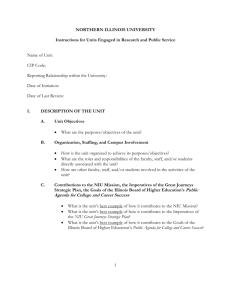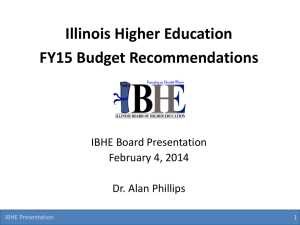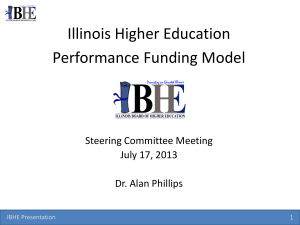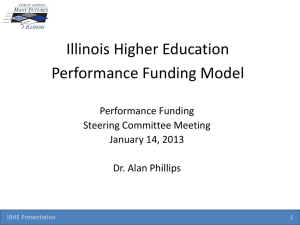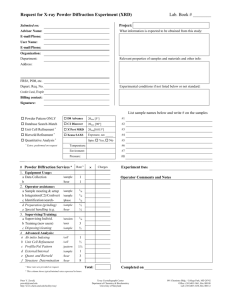Presentation - Illinois Board of Higher Education
advertisement
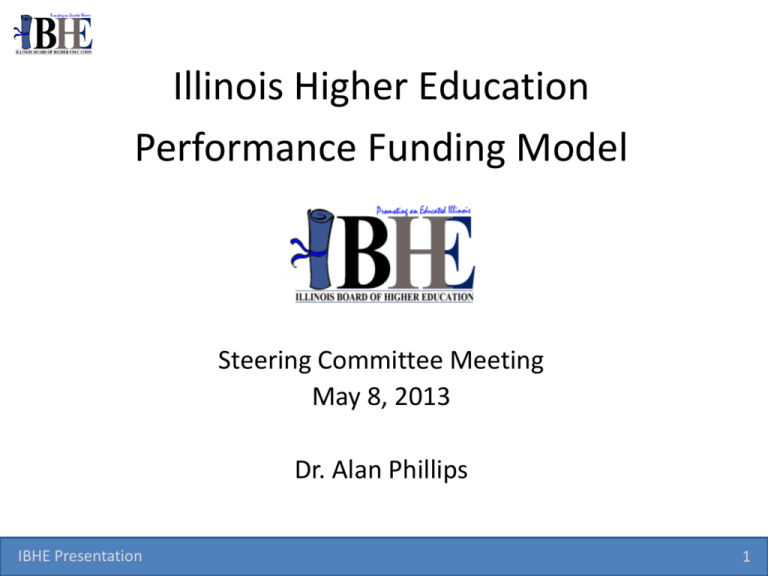
Illinois Higher Education Performance Funding Model Steering Committee Meeting May 8, 2013 Dr. Alan Phillips IBHE Presentation 1 Purpose • The purpose of this presentation is to identify and address issues associated with the refinement of the performance funding model that will allocate funding based on performance as a part of the FY 2015 IBHE Higher Education budget submission. • Accomplish this in accordance with the intent of Public Act 97-320 (HB 1503), the Performance Funding legislation, and the goals of the Illinois Public Agenda. IBHE Presentation 2 Performance Funding Objective • To develop performance funding models for public universities and community colleges that are… – Linked directly to the Goals of the Illinois Public Agenda and the principles of Public Act 97-320 – Equipped to recognize and account for each university’s mission and set of circumstances – Adjustable to account for changes in policy and priorities – Not prescriptive in how to achieve excellence and success IBHE Presentation 3 Public Act 97-320 (HB 1503) • Performance Metrics Shall: – Reward performance of institutions in advancing the success of students who are: • • • • Academically or financially at risk. First generation students. Low-income students. Students traditionally underrepresented in higher education. – Recognize and account for the differentiated missions of institutions of higher education. – Focus on the fundamental goal of increasing completion. – Maintain the quality of degrees, certificates, courses, and programs. – Recognize the unique and broad mission of public community colleges. IBHE Presentation 4 Considerations • All things being equal, simple is always better. • The model has to be complex enough to do what it needs to do and yet be simple enough that it can be explained to all stakeholders • The more measures we add, the more we dilute the weights for the existing measures. • This is not an exact science, and in some cases we are using proxies for what we really want to measure because direct measures are not available. • You cannot capture the infinite number of variables with nine measures and five sub-categories. • Data availability continues to be a problem, so we will use the best data we have. IBHE Presentation 5 FY13 Performance Measures Measure • Bachelors Degrees (FY07-09) • Masters Degrees (FY07-09) • Doctoral and Professional Degrees (FY07-09) • Undergraduate Degrees per 100 FTE (FY07-09) • Education and General Spending per Completion (FY09-11) • Research and Public Service Expenditures (FY09-11) IBHE Presentation Source IPEDS IPEDS IPEDS IPEDS RAMP RAMP 6 FY13 Sub-Categories Sub-Category • Low Income (Pell/Map Eligible) • Adult (Age 25 and Older) • Hispanic • Black, non-Hispanic • STEM & Health Care (by CIP Code) IBHE Presentation 7 FY14 Refinement Goals • Refine the existing measures and sub-categories to the extent possible or find replacement measures that capture what we are trying to measure in a better way (i.e. Research Expenditures, Low Income Students, Cost per FTE, etc.). – Identify additional measures and sub-categories to add to the model. – Identify better and more current sources of data. – See if there is a better way to scale (normalize) the data. – Discuss ways to account for other factors (i.e. Hospitals, Medical Schools, Dental Schools, etc.) IBHE Presentation 8 FY14 Changes to the Performance Measures • Deleted: – Education and General Spending per Completion (RAMP) • Added: – – – – Cost per Credit Hour. (Cost Study) Cost per Completion. (Cost Study) Credit Hour Accumulation. (Institutional Data) Graduation Rates (Institutional Data) IBHE Presentation 9 FY14 Changes to the Sub-Categories • Did not change the sub-categories. • Changed some of the sources of data. • Sub-Categories were: – – – – – IBHE Presentation Low Income (Pell/MAP Eligible) – Institutional Data Adult (Age 25 and Older) – CCA/ILDS Hispanic - IPEDS Black, non-Hispanic - IPEDS STEM & Health Care (By CIP Code) – HLS + CIP 51 10 Performance Funding Model (FY14) 4-Year Public Universities IBHE Presentation 11 Performance Funding Model Steps (4-Year Public University) • • • • • • • • Step 1 – Identify the performance measures or metrics that support the achievement of the state goals. Step 2 – Collect the data on the selected performance measures Step 3 – Award an additional premium (i.e. 40%) for the production of certain desired outcomes such as completions by underserved or underrepresented populations Step 4 – Normalize (scale) the data, if necessary, so it is comparable across variables. Step 5 – Weight each of the Performance Measures to reflect the priority of the Measure to the mission of the institution. Step 6 – Multiply and sum the Scaled Data times the Weight to produce the Weighted results. Step 7 – Add an adjustment factor for high cost entities (i.e. Hospitals, Medical, Dental, and Veterinary Schools). Step 8 – Use the final Weighted results (or Total Performance Value) to distribute performance funding. IBHE Presentation 12 Performance Measures Step 1 – Identify the performance measures or metrics that support the achievement of the state goals. Step 2 – Collect the data on the selected performance measures (3-year averages) Measure • Bachelors Degrees (FY09-11) • Masters Degrees (FY09-11) • Doctoral and Professional Degrees (FY09-11) • Undergraduate Degrees per 100 FTE (FY09-11) • Research and Public Service Expenditures (FY10-12) • Grad Rates 100%/150%/200% of Time (Fall 02-04 Cohort) • Persistence (Completed 24/48/72 Semester Hours) (FY07-09) • Cost per Credit Hour (FY09-11) • Cost per Completion (FY09-11) IBHE Presentation Source IPEDS IPEDS IPEDS IPEDS RAMP Institutional Data Institutional Data Cost Study Cost Study 13 Sub-Categories Step 3 – Award an additional premium for the production of certain desired outcomes such as completions by underserved or underrepresented populations Sub-Category Weight • Low Income (Pell/Map Eligible) 40% - Institutional Data • Adult (Age 25 and Older) 40% • Hispanic 40% • Black, non-Hispanic 40% • STEM & Health Care (by CIP Code) 40% - HLS + CIP 51 IBHE Presentation 14 Scaling Factors Step 4 – Normalize (scale) the data, if necessary, so it is comparable across variables. • Averaged the measures across all of the institutions. • The average number of bachelors degrees will serve as the base value. • Determine a scaling factor that will normalize the rest of the averages to the average number of bachelors degrees. • Adjust the scaling factors as appropriate (i.e. Masters & Doctorates). • Multiply all of the initial data by the scaling factor to normalize the data. IBHE Presentation 15 Scaling Factors Step 4 – Normalize (scale) the data, if necessary, so it is comparable across variables. Measure Universities 1-12 (Avg) 2,822 • Bachelors Degrees (FY09-11) 1,042 • Masters Degrees (FY09-11) 227 • Doctoral and Professional Degrees (FY09-11) 25 • Undergraduate Degrees per 100 FTE (FY09-11) 27 • Grad Rates 100% of Time (Fall 02-04 Cohort) 46 • Grad Rates 150% of Time (Fall 02-04 Cohort) 50 • Grad Rates 200% of Time (Fall 02-04 Cohort) 1,644 • Persistence (Completed 24 Semester Hours) (FY07-09) 1,453 • Persistence (Completed 48 Semester Hours) (FY07-09) 1,350 • Persistence(Completed 72 Semester Hours) (FY07-09) 346 • Cost per Credit Hour (FY09-11) (Cost Study) 36,566 • Cost per Completion (FY09-11) (Cost Study) • Research and Public Service Expenditures (FY09-11) 112,914,667 IBHE Presentation Scaling Factor Adjusted Scaling Factor 1.0 1 2.7 1 12.4 2 112.6 200 104.4 50 60.9 50 57.0 50 1.7 2 1.9 2 2.1 2 8.1 -8 .1 -.050 .00002 .00005 16 Performance Measure Weights Step 5 – Weight each of the Performance Measures to reflect the priority of the Measure to the mission of the institution. Research-Very High Measure • Bachelors Degrees • Masters Degrees • Doctoral and Professional Degrees • Undergraduate Degrees per 100 FTE • Grad Rates 100% of Time • Grad Rates 150% of Time • Grad Rates 200% of Time • Persistence (Completed 24 Semester Hours) • Persistence (Completed 48 Semester Hours) • Persistence (Completed 72 Semester Hours) • Cost per Credit Hour • Cost per Completion • Research and Public Service Expenditures IBHE Presentation UIUC 17.0% 14.0% 13.0% 4.0% 1.5% 1.0% 0.5% 0.5% 1.0% 1.5% 0.5% 0.5% 45.0% 100.0% UIC 18.0% 15.0% 14.0% 4.0% 1.5% 1.0% 0.5% 0.5% 1.0% 1.5% 0.5% 0.5% 42.0% 100.0% Doctoral/ Research Research-High NIU 28.0% 15.0% 10.0% 11.0% 1.5% 1.0% 0.5% 0.5% 1.0% 1.5% 1.0% 1.0% 28.0% 100.0% SIUC 28.0% 14.0% 8.0% 13.0% 1.5% 1.0% 0.5% 0.5% 1.0% 1.5% 0.5% 0.5% 30.0% 100.0% ISU 33.0% 23.0% 6.0% 12.0% 2.0% 1.5% 0.5% 0.5% 1.5% 2.0% 1.5% 1.5% 15.0% 100.0% 17 Performance Measure Weights Step 5 – Weight each of the Performance Measures to reflect the priority of the Measure to the mission of the institution. Masters Colleges & Universities (Large) Measure • Bachelors Degrees • Masters Degrees • Doctoral and Professional Degrees • Undergraduate Degrees per 100 FTE • Grad Rates 100% of Time • Grad Rates 150% of Time • Grad Rates 200% of Time • Persistence (Completed 24 Semester Hours) • Persistence (Completed 48 Semester Hours) • Persistence (Completed 72 Semester Hours) • Cost per Credit Hour • Cost per Completion • Research & Public Svc Expenditures IBHE Presentation SIUE WIU EIU NEIU CSU 42.0% 40.0% 40.0% 40.0% 40.0% 28.0% 25.0% 26.0% 26.0% 25.0% 2.5% 1.0% 0.0% 0.0% 1.0% 12.0% 13.0% 13.0% 13.0% 13.0% 2.0% 2.5% 2.5% 2.5% 2.5% 1.5% 2.0% 2.0% 2.0% 2.0% 1.0% 1.0% 1.0% 1.0% 1.0% 1.0% 1.0% 1.0% 1.0% 1.0% 1.5% 2.0% 2.0% 2.0% 2.0% 2.0% 2.5% 2.5% 2.5% 2.5% 1.5% 4.0% 4.0% 4.0% 4.0% 1.5% 4.0% 4.0% 4.0% 4.0% 3.5% 2.0% 2.0% 2.0% 2.0% 100.0% 100.0% 100.0% 100.0% 100.0% GSU UIS 45.0% 43.0% 27.0% 27.0% 1.0% 1.0% 5.0% 8.0% 0.0% 2.5% 0.0% 2.0% 0.0% 1.0% 5.0% 1.0% 7.0% 2.0% 0.0% 2.5% 4.0% 4.0% 4.0% 4.0% 2.0% 2.0% 100.0% 100.0% 18 Performance Value Calculation Step 6 – Multiply and Sum the Scaled Data times the Weight to produce the Performance Value for each institution. Data Measure 2,822 • Bachelors Degrees 1,042 • Masters Degrees 227 • Doctoral and Professional Degrees 25 • Undergraduate Degrees per 100 FTE 27 • Grad Rates 100% of Time 46 • Grad Rates 150% of Time 50 • Grad Rates 200% of Time 1,644 • Persistence (Completed 24 Semester Hours) 1,453 • Persistence (Completed 48 Semester Hours) 1,350 • Persistence (Completed 72 Semester Hours) 346 • Cost per Credit Hour 36,566 • Cost per Completion $112,914,667 • Research & Public Svc Expenditures IBHE Presentation (Data+Premium) Total Performance Data + Premium Scale x Scale xWeight = Value 3,522 1 3,522 30.0% 1,057 1,454 1 1,454 25.0% 364 240 2 480 5.0% 24 25 200 5,000 10.0% 500 27 50 1,350 1.5% 20 46 50 2,300 1.0% 23 50 50 2,500 0.5% 13 1,644 2 3,288 1.0% 33 1,453 2 2,906 1.5% 44 1,350 2 2,700 2.0% 54 345 -8 -2,760 1.5% -41 36,566 -.050 -1,828 1.0% -18 $112,914,667 .00005 5,646 20.0% 1,129 100.0% 3,200 19 Performance Value Calculation Step 7 – Add an adjustment factor for high cost entities (i.e. Hospitals, Medical, Dental, and Veterinary Schools) • Divide the amount of the university GRF appropriation allocated to fund the high cost entity by the total university GRF appropriation. • Multiply this factor by the university performance value and add the result back to the performance value. • This results in a total performance value for institutions with these high cost entities. • Example: $20M/$200M = .10 .10 X 3200 (PV) = 320 320 + 3200 = 3520 = Total Performance Value IBHE Presentation 20 Funding Allocation Based on Performance Step 8 – Use the Weighted results (or Total Performance Value) to distribute funding based on a Pro Rata Share of the total amount of funds set aside for performance funding. Percentages for Distribution Total Performance Value Percentage of Total Distribution: Pro Rata IBHE Presentation University 1 University 2 University 3 Total 10,840 58.7% 4,435 24.0% 3,200 17.3% 17,302 100% $240,000 $173,000 $1,000,000 $587,000 21 Results for FY14 • Performance funding values increased for all twelve of the four-year public universities from FY13 to FY14. • Assuming a .5% funding set-aside and a 4.95% reduction in GRF Funding: – Variance in funding allocations due to performance ranged from +.21% to -.22%. – The actual funding amount variance ranged from +$70K to -$101K. IBHE Presentation 22 FY14 Performance Funding Allocation ($ in thousands) FY2013 FY2014 Budget Reduction Appropriation $ 1,230,092.0 $ 1,169,202.4 FY2014 % Change (4.95) % Set Aside* $ Performance Funding FY2014 FY2014 Performance Funds Net Change 5,866.3 $ 5,866.3 $ FY2014 Final Allocation FY2013 - FY 2014 % $ Change Change 0.0 $ 1,169,202.4 $ (60,889.6) (4.95) Chicago State University 36,805.6 34,983.7 (4.95) 175.4 136.9 -38.5 34,945.2 (1,860.4) (5.05) Eastern Illinois University 44,041.1 41,861.1 (4.95) 210.2 244.9 34.7 41,895.8 (2,145.3) (4.87) Governors State 24,650.5 23,430.3 (4.95) 117.7 140.7 23.0 23,453.3 (1,197.2) (4.86) Illinois State University Northeastern Illinois University 74,082.4 70,415.3 (4.95) 353.3 359.2 5.9 70,421.2 (3,661.2) (4.94) 37,807.6 35,936.1 (4.95) 180.4 217.9 37.5 35,973.6 (1,834.0) (4.85) Northern Illinois University 93,470.2 88,843.4 (4.95) 445.6 390.1 -55.4 88,788.0 (4,682.2) (5.01) Western Illinois University 52,147.8 49,566.5 (4.95) 248.7 258.1 9.4 49,575.8 (2,572.0) (4.93) 204,693.8 194,561.5 (4.95) 975.8 870.1 -105.7 194,455.7 (10,238.1) (5.00) 145,316.4 138,123.2 (4.95) 692.8 591.8 -101.0 138,022.2 (7,294.2) (5.02) 59,377.4 56,438.2 (4.95) 283.0 278.2 -4.7 56,433.5 (2,943.9) (4.96) 662,393.0 629,604.5 (4.95) 3,159.3 3,248.5 89.3 629,693.8 (32,699.2) (4.94) 305,571.6 290,445.8 (4.95) 1,457.4 1,479.2 21.8 290,467.6 (15,104.0) (4.94) 23,152.7 22,006.6 (4.95) 110.5 108.0 -2.5 22,004.1 (1,148.6) (4.96) 333,668.7 317,152.1 (4.95) 1,591.4 1,661.3 70.0 317,222.1 (16,446.6) (4.93) Southern Illinois University ** Carbondale Edwardsville University of Illinois *** Chicago Springfield Urbana/Champaign FY2014 Set Aside for allocation per performance funding is based on a 0.5% reallocation of a $1.173 billion budget for public universities. Governor's budget proposal cuts public university funding by 4.95% from the FY2013 appropriation. SIU Administration is allocated on a pro-rated basis to each campus, SIU School of Medicine is included with the Carbondale Campus. UI Administration is allocated on a pro-rated basis to each campus. IBHE Presentation 23 Refinement Issues for FY15 • What is the best way to account for the difficulty of getting underrepresented students through to completion throughout the model? • What is the best way to account for less prepared students in the model? • Are there differences in the cost per completion for different sub-categories of students (i.e. is cost for completion for an adult student different than that of a STEM student)? Should that be integrated in the model? • What is the best way to address the issue of transfer students and part-time students? IBHE Presentation 24 Refinement Issues for FY15 • Are there other high value degrees and programs, in addition to the STEM programs, that we should add to the model? • Are we giving enough priority to measures of efficiency? • What is the best way to account for high cost entities (i.e. Hospitals and Medical, Dental, and Veterinary schools)? • Are we adequately accounting for institutional improvement from year to year? • Do we change the measures or the sub-categories? • Do we change the sources of the data for the model? IBHE Presentation 25 Refinement Issues for FY15 • What is the best way to account for the difficulty of getting underrepresented students through to completion throughout the model? – Four of the five sub-categories address underrepresented students and these sub-categories are weighted in the Bachelors, Masters, and Doctoral completion measures. – They are, however, not weighted in the Cost per Completion or the Completion per 100 FTE measures. – Do we weight the completions in these two categories, and if so, do we readjust the sub-category weights so as to not overweight these two categories in the model? – Are there other ways to account for the challenge of educating these students that we should consider? • Refinement Committee: Take a look at the results of the current methodology relative to the results of weighting these students throughout the model to determine which method would produce better results. IBHE Presentation 26 Refinement Issues for FY15 • What is the best way to account for less prepared students in the model? – We do not currently have a good way to track these students. – These students tend to be underrepresented students which are already captured in the sub-category weightings. – One possibility would be to add another subcategory for remedial students • (defined as first-time undergraduate students who complete remedial education courses in math, English/reading, or both, and are awarded a bachelors degree – (CCA Definition)) • Refinement Committee – No change to the model. These students are adequately accounted for in the existing model. IBHE Presentation 27 Refinement Issues for FY15 • Are there differences in the cost per completion for different sub-categories of students (i.e. is cost for completion for an adult student different than that of a STEM student)? Should that be integrated in the model? – There are differences in the costs between sub-categories. – The costs for each sub-category would vary by institution. – There is no data available to determine those costs. – We do not know how we would incorporate these cost differentials into the model. • Refinement Committee – No change to the model. Would significantly complicate the model, with marginal benefit. IBHE Presentation 28 Refinement Issues for FY15 • What is the best way to address the issue of transfer students and part-time students? – By definition, IPEDS data does not include transfer or part-time students in the calculation of graduation rates or retention measures. – Based on survey input provided by the institutions, with few exceptions, part-time students were low density students and did not significantly affect the model outcome. – For transfer students, it might be possible to use CCA transfer categories (i.e. 30 or fewer credits, 31 to 59 credits, or 60 or more credits) • Refinement Committee – Part-time student numbers will not be included due to their low density. Transfer student numbers will be incorporate in the Graduation Rate and Persistence Measures. As these numbers are not reflected in IPEDS, transfer student numbers will be provided by the institutions. IBHE Presentation 29 Refinement Issues for FY15 • Are there other high value degrees and programs, in addition to the STEM programs, that we should add to the model? – The current STEM program list consists of the Homeland Security (HLS) STEM program list and the CIP Code 51. – There are other programs that could be added to the list of STEM programs such as behavioral or health/nutrition related fields. – When you begin to move away from clearly defined criteria, the determination of what should or should not be STEM, becomes much less clear and much more subject to interpretation. • Refinement Committee – Stay with the current list of STEM programs (i.e. HLS List + CIP 51). IBHE Presentation 30 Refinement Issues for FY15 • Are we giving enough priority to measures of efficiency? – Current measures of efficiency include: • Undergraduate Degrees per 100 FTEs • Graduation rates per percentage of time • Cost per Credit Hour • Cost per Completion – Should these measures be given increased weighting? – Should we add additional efficiency measures? • Refinement Committee – No change to the model. Given there are four efficiency measures, the Refinement Committee viewed the existing weighting to be sufficient and expressed concern that the addition of another efficiency measure would only serve to dilute the weighting of the other existing performance measures. IBHE Presentation 31 Refinement Issues for FY15 • What is the best way to account for high cost entities (i.e. Hospitals and Medical, Dental, and Veterinary schools)? – Need to be accounted for in the model in some way. – Current methodology - Does not account for all of the costs. – Complete Carve-Out – However, some schools benefit in the model from these entities (i.e. Completions and Public Service Expenditures). – Is there another method that would better account for these nonperformance costs in the model? – Are their other high cost entities that should be added to the list? • Refinement Committee – A complete carve-out would create additional problems and issues. Therefore, we will work to develop a better methodology to account for these entities. No other high cost entities should be added at this time. IBHE Presentation 32 Refinement Issues for FY15 • Are we adequately accounting for institutional improvement from year to year? – Every institution improved its performance funding scores from FY13 to FY14. – There has been some discussion that each institution should be measured against itself. • Until the performance funding model is stabilized, the scores from the current year are not directly comparable to the scores from the previous year due to changes in the model from year to year. • In the future, the performance value for each institution could be compared against the previous performance value for that institution. • The scores for each individual measure at each institution can be compared against the previous scores for those measures at each institution where they are consistent from year to year. • Refinement Committee – No change to the model at this time. We can relook this issue once we get to a point where the model does not change from year to year. IBHE Presentation 33 Refinement Issues for FY15 • Do we change the measures or the sub-categories – Do we change the Graduation Rate Measure(s)? – Do we change the Credit Hour Accumulation Measure(s)? – Do we add to the sub-categories (i.e. a remediation measure)? • Do we change the sources of data for the model? – – – – IPEDs Survey CCA Cost Study • Refinement Committee – Use the 150% of Time, Graduation Rate Measure, but incorporate transfer students per the CCA definitions. (Survey Data) – Use the 24 Semester Credit Hours Completed in the First Year Measure, to include credits earned at other institutions. (Survey Data) – Do not add any additional sub-categories. – Continue to use the existing data sources. IBHE Presentation 34 Performance Funding Model Steps (4-Year Public University) • • • • • • • • Step 1 – Identify the performance measures or metrics that support the achievement of the state goals. Step 2 – Collect the data on the selected performance measures. Step 3 – Award an additional premium (i.e. 40%) for the production of certain desired outcomes such as completions by underserved or underrepresented populations Step 4 – Normalize (scale) the data, if necessary, so it is comparable across variables. – (No change to the Scaling Methodology) Step 5 – Weight each of the Performance Measures to reflect the priority of the Measure to the mission of the institution. Step 6 – Multiply and sum the Scaled Data times the Weight to produce the Weighted results. Step 7 – Add an adjustment factor for high cost entities (i.e. Hospitals, Medical, Dental, and Veterinary Schools). Step 8 – Use the final Weighted results (or Total Performance Value) to distribute performance funding. Bold - Indicates Steps that are under review by the Refinement Committee IBHE Presentation 35 FY15 Performance Measures Measure Source • Bachelors Degrees (FY10-12) IPEDS • Masters Degrees (FY10-12) IPEDS • Doctoral and Professional Degrees (FY10-12) IPEDS • Undergraduate Degrees per 100 FTE (FY10-12) IPEDS • Research and Public Service Expenditures (FY11-13) RAMP • Graduation Rate - 150% of Time (Fall 03-05 Cohort)* Institutional Data • Persistence-Completed 24 Semester Hours in One Year (FY08-10)*Institutional Data • Cost per Credit Hour (FY10-12) Cost Study • Cost per Completion (FY10-12) Cost Study * Incorporate transfers per the CCA transfer category definitions. IBHE Presentation 36 FY15 Sub-Categories Sub-Category Weight • Low Income (Pell/Map Eligible) 40% - Institutional Data • Adult (Age 25 and Older) 40% • Hispanic 40% • Black, non-Hispanic 40% • STEM & Health Care (by CIP Code) 40% - HLS + CIP 51 IBHE Presentation 37 Other FY15 Issues Yet to be Resolved • Determine whether or not to carry the weighted sub-categories all the way through the model. • Develop a better methodology to account for the high cost entities in the model. • Continue to work with the institutions to improve the quality of available data for use in the performance funding model. IBHE Presentation 38 Next Steps • Steering Committee Meeting – May 8, 2013. • Incorporate input from the Steering Committee. • Continue work to resolve the issues. • IBHE Board Meeting – June 4, 2013. • Recommend changes to the model at the next refinement committee meeting – June 27, 2013. • Continue work to resolve the issues. • Steering Committee Meeting – July 17, 2013 IBHE Presentation 39 Questions/Comments? IBHE Presentation 40
